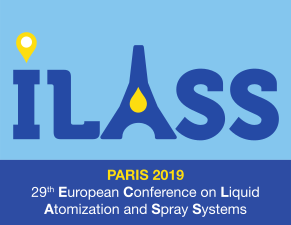Nanofluids are promising candidates for improving combustion performance through reducing emissions (as a fuel spray additive) or as spray coolants in various thermal management systems (by enhancing the surface heat transfer rate). In this study, experiments were conducted to compare the viscosity, free spray properties and the cooling performance of a water spray with an Alumina nanofluid spray prepared using an ultrasonic bath. A commercial, gasoline, port-fuel injector was used to spray Aluminum oxide nanoparticle solutions at a pressure of 3 bar (40-50 nm, 0, 0.01 and 0.07% by mass) onto a heated, smooth Aluminum surface, mimicking the geometry of a bowled engine piston. The temperature of the piston surface was varied in the range of 25-180 °C (above the Leidenfrost temperature). A Phase Doppler Anemometer was used to measure the droplet size and axial and radial velocity distributions at a series of points, with and without spray impingement. Incident and rebounding axial droplet velocities were recorded in the ranges of 4 to 7 ms-1 and -0.8 to 0.8 ms-1 respectively for all sprays. High-speed video observations showed that the approximate spray cone envelope angle was reduced from 26° to 19° with the addition of nanoparticles. The mean droplet diameter in the case of the nanofluids was consistently greater (generally between 10 and 30% for the 0.07% case) when compared to the water spray and evidenced by pooling and splashing on the piston surface. For the heated piston cases, the heat transfer effect was only enhanced in the case of the 0.07% mass concentration, resulting in a 15 °C reduction in surface temperature after 35 seconds when compared to the water case, decreasing from 165 to 110 °C at an injection frequency of 25 Hz and duration of 8 ms. A much smaller effect was observed in the central bowl location; approximately 3-5 °C after 20 seconds. The main boiling regimes were observed as the surface cooled. The transition to single-phase cooling occurred approximately 10 seconds earlier in the water case for the location directly under the impinging spray jet. The heat transfer rate showed a stronger correlation between droplet number count and droplet diameter at the surface in the case of the nanofluid compared to water. The deposition of a rough, solid film of Aluminum oxide on the piston surface at the point of spray impact was observed and considered to contribute to the enhanced heat transfer effect.
|
|
|
Proceedings > Papers by author > Tokkan OA Comparative Study of the Spray Characteristics of Nanofluids and Spray Cooling Performance
1 : School of Computing, Engineering and Mathematics
University of Brighton, Watts Building, Lewes Road, Brighton BN2 4GJ -
United Kingdom
2 : Faculty of Engineering, Environment and Computing
* : Corresponding author
Priory Street, Coventry, CV1 5FB -
United Kingdom
|
| Online user: 62 | RSS Feed |

|

 PDF version
PDF version